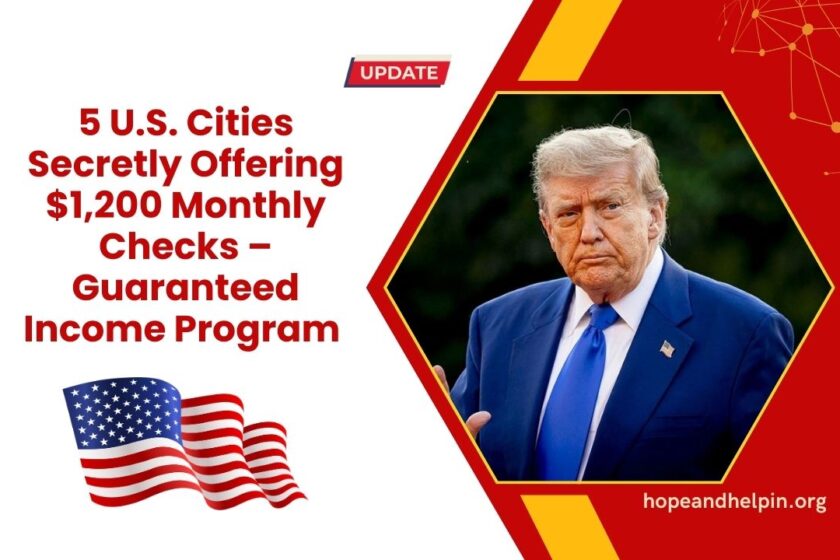The cost of living has skyrocketed since the pandemic, with consumer prices up more than 24%. Everyday essentials like groceries, rent, and gas are draining household budgets, leaving millions of Americans struggling to stay afloat.
In response, several U.S. cities and counties have quietly launched guaranteed income programs—initiatives that hand out up to $1,200 per month in no-strings-attached cash payments.
These programs are designed to help vulnerable families cover basic needs and build financial stability. Let’s take a look at five key programs currently offering these hidden lifelines.
Cities Offering $1,200 Monthly Checks
| Location | Target Group | Monthly Amount | Duration / Total Value | Details |
|---|---|---|---|---|
| Santa Clara County, CA | Former foster youth, unhoused students, justice-involved, young parents | $1,200 | 2 years; nearly $25 million distributed to ~800 individuals | Four pilot groups; enrollment via referrals only. |
| San Francisco, CA | Low-income transgender residents | $1,200 | Up to 18 months | The GIFT Program offers cash plus community support services. |
| California (Statewide) | Former foster youth in San Francisco & Ventura | $1,200 (SF) / $1,000 (Ventura) | 18 months; state-funded pilots | Hundreds of youth supported with consistent monthly checks. |
| Stockton & Other Cities, CA | Pregnant parents and foster youth | $600–$1,200 | 12–18 months; $25M in funding for ~2,000 individuals | Pilot programs test outcomes of direct cash support. |
| Santa Clara Expansion, CA | General low-income families | $1,200 | Up to 2 years | Focus on economic stability and reducing generational poverty. |
Other Notable Guaranteed Income Programs
While these five programs focus specifically on $1,200 monthly payments, other cities also provide significant guaranteed income support:
- Franklin County, Ohio – Families experiencing homelessness receive an initial $1,500, followed by $500/month for nearly a year.
- Howard County, Maryland – Families in need get $1,000/month for 12 months along with supportive services.
- Alameda County, California – 100 families received a $3,000 upfront payment, followed by $1,000/month for 12 months, tapering off afterward.
- Georgia’s “In Her Hands” – More than 900 women receive $1,000/month for 2–3 years, making it one of the South’s largest programs.
Why $1,200 Matters
The $1,200/month figure is not random. It reflects a substantial sum that allows households to:
- Cover rent or housing costs in high-cost areas.
- Buy groceries and essentials without turning to credit cards.
- Pay utility bills and transportation expenses more easily.
- Save for emergencies and unexpected challenges.
Unlike traditional welfare, these programs place trust in recipients to decide what works best for their families.
Key Features of These Programs
- Unconditional Payments
No restrictions on how the money is spent. Families choose what they need most. - Targeted Groups
Programs focus on foster youth, low-income parents, justice-involved individuals, and LGBTQ+ residents who face systemic barriers. - Pilot Programs
Most efforts run for 12–24 months to test results before expansion. - Mixed Funding
Backed by a blend of local governments, nonprofits, and philanthropic grants, ensuring wider coverage. - Supportive Services
Some programs add financial coaching, career guidance, and wellness resources to strengthen long-term outcomes.
Impact on Communities
The results so far have been encouraging. Families report:
- Reduced financial stress
- Better ability to keep up with bills
- Improved mental health and family stability
- Greater focus on education and employment
These programs demonstrate that direct cash transfers can be a powerful tool to fight poverty and create opportunities.
With inflation leaving millions of Americans struggling, guaranteed income programs are quietly reshaping the way local governments support vulnerable communities.
Cities like Santa Clara and San Francisco are showing that giving families $1,200/month in direct aid can transform lives, reduce poverty, and create lasting stability.
As more pilots expand, these programs may pave the way for a broader national model of guaranteed income—one that ensures financial dignity for all.
FAQs
Who qualifies for the $1,200 monthly checks?
Eligibility varies. Common groups include foster youth, unhoused students, low-income transgender residents, justice-involved individuals, and young parents. Most programs enroll participants through referrals.
How long do the payments last?
Programs range from 12 months to 2 years. For example, Santa Clara offers two-year payments, while San Francisco’s program runs up to 18 months.
Do recipients have to report how they spend the money?
No. The payments are unconditional, allowing participants to spend freely on needs like housing, food, childcare, or savings.

